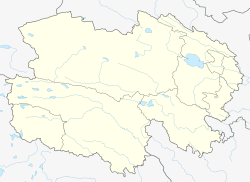Top Qs
Timeline
Chat
Perspective
Nangqên County
County in Qinghai, China From Wikipedia, the free encyclopedia
Remove ads
Nangqên County, or Nangchen (Tibetan: ནང་ཆེན་རྫོང་།, Chinese: 囊谦县), is currently a county of the Yushu Tibetan Autonomous Prefecture and is the southernmost county-level division of Qinghai province, China, bordering the Tibet Autonomous Region to the south. Until 1951, the region was known as the Kingdom of Nangchen.[2] It was one of the five kingdoms of the historical region of Do Kham.[citation needed]
The county seat is Xangda, built in a side valley and on the right bank of the Dza Chu (upper reaches of the Mekong). In 2000, the county's population amounted to 57,387 people, inhabiting a surface of 11,539 km2 (4,455 sq mi).
Remove ads
History

The county's name is derived from the former king (nang chen rgyal po) and Kingdom of Nangchen, a tribal confederation that emerged as a unified Buddhist kingdom in the 13th century.[3] The present-day's county comprises the core area of the old kingdom of Nangchen.
Memories of the Kingdom of Nangchen play a role in local politics, and among Tibetan refugees who came to India from the area. Scholar Maria Turek reported that in 2015 she heard about “a man who went to various Tibetan communities in India, introducing himself as ‘the king of Nangchen’ not without some success, even though he had no credentials to prove his claim.”[4]
A Yelpa Kagyu monastery, Tana Monastery (Jang Tana), was founded by Yelpa Yeshe Tsek in 1068. It is considered a branch monastery of Tsurpu.[5][6][7][8]
Remove ads
Administrative divisions
Nangqên County is divided to 1 town and 9 townships.
Remove ads
Climate
Transportation
References
External links
Wikiwand - on
Seamless Wikipedia browsing. On steroids.
Remove ads



